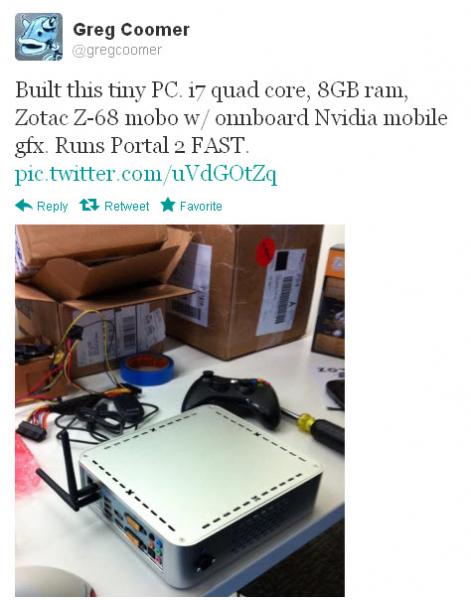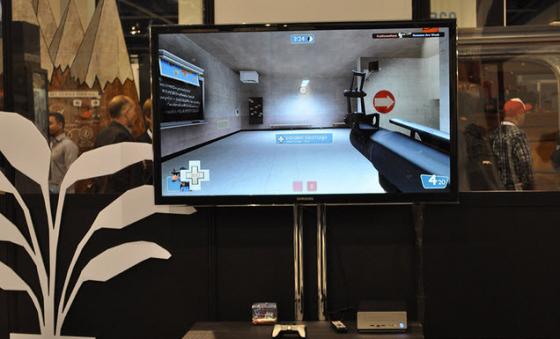The Steam Box
The Steam Box has been a heavily rumoured concept since March 2012 after a misconception of a demo-model to demonstrate Steam's Big Picture service which allows gamers to connect their computer to a TV screen and navigate the menus with a controller. Not long after this rumour spread, a tweet from Valve employee, Greg Coomer was dug up. This tweet detailed that he was working on a tiny PC and listed the specs. For most, this was as good as fact.

Shortly after this whole affair, Valve came in and stomped on our hearts saying:
We're prepping the Steam Big Picture Mode UI and getting ready to ship that, so we're building boxes to test that on.
- Valve marketing director Doug Lombardi
Following this, rumours floated around the internet as they do, but largely, people forgot about a steam box and moved on with their lives. Well, at least until the Customer Electronics Show (CES) in Las Vegas when Xi3 brought out the "Piston". It didn't take people that long to the link of Piston to Valve and Steam. Xi3 then confirmed that the Piston is designed specifically to support Steam and more importantly, its Big Picture mode, however, they stated that Valve's role was solely as investors within the company and nothing more.

The next day Gabe Newell, CEO of Valve Corporation, was interviewed by The Verge which cleared up rumours and speculation. To start off with, Gabe cleared up why they are only an investor in Xi3 and not a partner stating that Valve will be working on their own Steam Box but aren't stopping others from getting involved and creating their own revisions.
We try to take the pieces where we're going to add the best value and then encourage other people to do it. So it tends to mean that a lot of people get involved. We're not imposing a lot of restrictions on people on how they're getting involved. We'll come out with our own and we'll sell it to consumers by ourselves. That'll be a Linux box, [and] if you want to install Windows you can. We're not going to make it hard. This is not some locked box by any stretch of the imagination. We also think that a controller that has higher precision and lower latency is another interesting thing to have.
Newell then went onto explain that their Steam Box will be controller based because after extensive research into motion control, they can't see how it makes the game any better. They are looking into biometric controllers as a plausible method.
Maybe the motion stuff is just failure of imagination on our part, but we're a lot more excited about biometrics as an input method. Motion just seems to be a way of [thinking] of your body as a set of communication channels. Your hands, and your wrist muscles, and your fingers are actually your highest bandwidth — so to trying to talk to a game with your arms is essentially saying "oh we're going to stop using ethernet and go back to 300 baud dial-up." Biometrics on the other hand is essentially adding more communication bandwidth between the game and the person playing it, especially in ways the player isn't necessarily conscious of. Biometrics gives us more visibility. Also, gaze tracking. We think gaze tracking is going to turn out to be super important.

Moving on from controllers, the question was put to Gabe about multiple screens. PC gamers are quite used to gaming across multiple screens whether that be using one screen for a game and the others for whatever you seem fit or spreading a game across all your monitors but Steam has other ideas.
The Steam Box will also be a server. Any PC can serve multiple monitors, so over time, the next-generation (post-Kepler) you can have one GPU that's serving up eight simultaneous game calls. So you could have one PC and eight televisions and eight controllers and everybody getting great performance out of it. We're used to having one monitor, or two monitors — now we're saying let's expand that a little bit.
Gaming at home isn't the only method of gaming of course and Gabe explained what Valve's plans are for moving into the portable gaming space. He explains that there is a lot to be done within the tablet and mobile to improve their gaming potential and doesn't think that by throwing a touch-pad onto something, makes it portable.
In one of the designs that we're building on the controller side, it has this touchpad and we're trying to figure out where that's useful. We don't want to waste people's money by just throwing in a touchpad. Once we understand what the role is of multitouch in these kind of applications then it's easy to say you can use your phone for it.
So what can we hope to expect from Valve in the coming months (or, given their approach to Half-Life 3, years)? We could have a real contender for the console on our hands here as the creation of a Steam Box won't be solely down to Valve such as the likes of Xbox and PlayStation. The boxes will be relatively open-source as well so you could just as easily build your own Steam Box to sit beneath your ridiculously sized TV to play all your favorite Steam games on. Judging by what Gabe has said, it could even be possible to have a handful of Steam Boxes running but have an entire 50-man LAN run off them, all playing different or the same games with relative comfort. To match this new type of device will be a new type of controller, possibly containing biometric technology to assist in the gaming experience. And last but not least, we could see some changes in the mobile gaming market as the internally known project, Littlefoot is molded and developed. From what I have heard so far, the Steam Box should really give Microsoft and Sony a run for their money.









COMMENTS